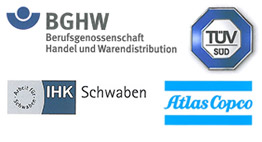Radler & Ruf vortex stream blasters are equipped with a special whirl jet nozzle to enable an absolutely smooth, effective and environmentally responsible surface treatment.
The vortex stream head allows the execution of three different blasting methods with just one basic nozzle, i. e. dry processing,
fog processing and wet processing. Furthermore, the basic nozzle can be used in an effectiv and efficient way by exchanging special components like:
- Whirl jet nozzle (extremely gentle to surfaces)
- Flat spray nozzle (wide flat jet)
- Round jet nozzle (with highly abrasive effect)
 The vortex stream head sets new standards for the area performance, surface technique and surface restoration. Read more about this procedure by going to Whirl Jet Nozzles.
The vortex stream head sets new standards for the area performance, surface technique and surface restoration. Read more about this procedure by going to Whirl Jet Nozzles.
The applied blasters can steplessly be adjusted due to the pressure control which is mounted directly at the device, so blasting may start with a pressure of 1 bar (by using 24-litre-devices up to 8 bar, all others up to 10/12 bar). We are recommending a pressure between 1 and 4 bar. The minimum pressure when using the remote control is 4 bar.
The hopper bottom being molded at 45° in combination with the vibrator provides for a smooth flow of the abrasive material and the water and/or cyclone separator guarantees an unobstructed operation of the blaster. Any waste of abrasives can be omitted by the easily adjustable dosing valve.
The blaster can directly be started or stopped by using either the pneumatic or electric remote control at the boiler and the deadman's switch at the nozzle, so corresponding standards of safety can be met perfectly.
Typical scopes for the use of our vortex stream blasters are filigree works in the restoration and refurbishment sector as well as the removal of graffiti.
Generally, our vortex stream blasters are equipped with the following components:
- Self-closing quick release cone
- Dosing valve for abrasives (fine tuning)
- Pressure control
- All fittings
- Vortex stream head for dry and wet processing with nozzle holder and bolt, vertebral body, water regulation and rewash equipment (mounted at the blasting hose)
- Water separator
- Pneumatic remote control, 2 parts with lever valve and silencer
- Abrasive sieve
- Lid
- Blasting hose with dual control pipe, hose coupling and nozzle holder
For a full version we are recommending:
- Vibrator (mounted at the device)
- Extension of blasting hose (length according to your needs) with dual control pipe and hose couplings
- Aftercooler ACA 003 designed for construction sites, volumetric flow 3m³/min. up to 16 bar, automatic water drainage, electric motor 220 V
- 10 m compressor hose 3/4" with Mody screw couplings
Technical differences among the various litre classes:
| 24 Litre | 60 Litre | 100(99) Litre | |
|---|---|---|---|
| Water separator | 1/2" | 1" | 1" |
| Dosing valve for abrasives | 1/2" | 1/2" | 1 1/4" |
| Length of blasting hose | 10 m | 10 m | 15 m |
| Diameter of blasting hose | 16 mm | 16 mm | 25 / 32 mm |
| Pressure (Blasting tank) * | 8/12 bar | 12 bar | 10 bar |
Measurements and weights of the various litre classes:
all measurements (in cm) and weights (in kg) for device with sieve and lid
| 24 Litre | 60 Litre | 100(99) Litre | |
|---|---|---|---|
| Device H x W x D | 90 x 55 x 50 | 106 x 62 x 69 | 129 x 79 x 82 |
| Diameter of boiler | 26 | 41 | 51 |
| Weight | 40 | 71 | 117 |
* The presssure of the blasting tank is relevant for the periodic control of § 15 (Industrial safety regulations).
Have you any further questions, please contact us.





















